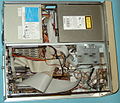Power converter
Converter (engl. Powerconverter ) are resting electrical equipment or systems - that is, without moving parts, but not necessarily stationary - for converting a supplied electric current type ( DC , AC ) in the other, or characteristic for changing parameters such as the voltage and the frequency . Often both principles are used in combination, for example in a PC switched-mode power supply that converts the AC mains voltage of 230 volts into a direct voltage which is also many times lower at typically 5 volts.
There are different designs or types of power converters for a wide range of application areas. The device class has considerable technical and economic importance, so power converters are nowadays found in a large proportion of electrical devices operated with mains current , and they are also an important part of modern systems for power generation and distribution . The conversion is typically carried out using electronic components based on semiconductor materials . Some converter types also contain a transformer , which is often operated at high frequency for reasons of efficiency .
Types of power converters
Converter for converting alternating current into direct current hot Rectifier (Engl. Rectifier ). Inverters ( inverted rectifiers or power inverters ) convert direct current into alternating current. For the conversion of an AC type to another are inverter (engl. Frequency changer ) used; For example, the frequency converter is used to change an alternating current frequency . DC converter (Engl. DC-to-DC converter ) to convert a first DC voltage into a second DC voltage that can be higher or lower inverted. The conversion is generally carried out with the help of electronic components based on semiconductors - for example with diodes , transistors or thyristors , in particular by means of MOSFETs , IGBTs and IGCTs . In the past, vacuum tubes , mercury vapor rectifiers and thyratrons were also used. Capacitors or inductors are often used as intermediate energy storage in the devices .
Differentiation from other technologies
On the other hand, rotating systems, in which the conversion is carried out by generators driven by electric motors, are called converters . In new systems, these have now been replaced by power converters. Similar to a transformer , a converter converts electrical energy , but in contrast to the latter, it is by definition not considered an electrical machine - because a converter generally does not have a magnetic circuit as a central element or, if it exists, this for the interaction with the semiconductor Circuit is designed.
Application examples
Power supply
One of the most common applications of power converters is electrical power supplies in the form of switched-mode power supplies . These have almost completely displaced the previously common power supplies with transformers and can now be found in almost every electronic device, especially in personal computers , entertainment electronics and as a plug-in power supply, e.g. B. for mobile phones , digital cameras or WLAN routers . The devices are usually supplied with AC voltage on the input side , while the power supply unit supplies DC voltage with a fixed or adjustable voltage value at the output, and with PCs also with several different voltage values. The capacitor power supply is a simpler design .
Engine control
Converters are also used to control and regulate variable-speed electric motors , so-called four - quadrant controllers are often used as control. The most important application in this context is use in electrically powered rail and road vehicles such as high-speed trains , electric locomotives , trams , trolleybuses as well as electric and hybrid cars . Other applications relate to pumps , fans and machine tools . With the latter, the speed , the rotational position or the torque to be output are usually used as control variables . The motors controlled in this way by control electronics are sometimes referred to as servo motors .
Industrial high current applications
Another application of power converters are electrolysis and smelting processes in the metal industry . Here an alternating voltage of a few volts is generated by a transformer , which is converted by high-current rectifiers into the required direct voltage with low voltage (in the range of a few volts) at very high currents (in the range of several thousand amps).
High voltage power transmission
In the case of high-voltage direct current transmission , too , the rectifying and inverting of the electrical current are carried out by converters. The conversion of three-phase current into direct current and vice versa takes place in a converter station . In addition to the converter, this also includes converter transformers that are connected upstream or downstream of the converter on the three-phase current side . The converter transformers are not only used to adapt the voltage of the three-phase network to that of the HVDC , but also to eliminate numerous harmonics .
Older power lines mercury vapor rectifiers from Siemens for 560 V and 1330 A
Controlled rectifier towers each consisting of 96 thyristors for 250 kV and 2000 A, RU Canadian Manitoba Hydro
Thyristor towers in the converter hall of a high-voltage direct current transmission , for size see person at the bottom of the picture
Encapsulated DC-DC converter in module design for circuit boards placement, dimensions approximately 13 mm x 10 mm x 7 mm
A solar inverter mounted under a solar open space system
A smaller mobile inverter for converting 12 V DC voltage (e.g. the on-board voltage of a car) into 230 V mains AC voltage
An open desktop PC from above; the sheet metal housing of the switched-mode power supply is on the top left
literature
- Gert Hagmann: Power electronics. 3. Edition. AULA-Verlag GmbH, Wiebelsheim 2006, ISBN 978-3-89104-700-2 .






